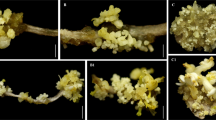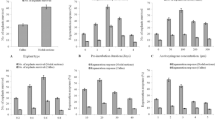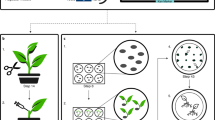Abstract
Agrobacterium-mediated transformation of friable embryogenic calli (FEC) is the most widely used method to generate transgenic cassava plants. However, this approach has proven to be time-consuming and can lead to changes in the morphology and quality of FEC, influencing regeneration capacity and plant health. Here we present a comprehensive, reliable and improved protocol, taking ∼6 months, that optimizes Agrobacterium-mediated transformation of FEC from cassava model cultivar TMS60444. We cocultivate the FEC with Agrobacterium directly on the propagation medium and adopt the extensive use of plastic mesh for easy and frequent transfer of material to new media. This minimizes stress to the FEC cultures and permits a finely balanced control of nutrients, hormones and antibiotics. A stepwise increase in antibiotic concentration for selection is also used after cocultivation with Agrobacterium to mature the transformed FEC before regeneration. The detailed information given here for each step should enable successful implementation of this technology in other laboratories, including those being established in developing countries where cassava is a staple crop.
This is a preview of subscription content, access via your institution
Access options
Subscribe to this journal
Receive 12 print issues and online access
$259.00 per year
only $21.58 per issue
Buy this article
- Purchase on Springer Link
- Instant access to full article PDF
Prices may be subject to local taxes which are calculated during checkout


Similar content being viewed by others
References
Balat, M. & Balat, H. Recent trends in global production and utilization of bio-ethanol fuel. Appl. Energ. 86, 2273–2282 (2009).
Ceballos, H., Iglesias, C.A., Pérez, J.C. & Dixon, A.G.O. Cassava breeding: opportunities and challenges. Plant Mol. Biol. 56, 503–516 (2004).
Taylor, N., Chavarriaga, P., Raemakers, K., Siritunga, D. & Zhang, P. Development and application of transgenic technologies in cassava. Plant Mol. Biol. 56, 671–688 (2004).
Raven, P., Fauquet, C., Swaminathan, M.S., Borlaug, N. & Samper, C. Where next for genome sequencing? Science 311, 468 (2006).
Li, H.Q., Sautter, C., Potrykus, I. & Puonti-Kaerlas, J. Genetic transformation of cassava (Manihot esculenta Crantz). Nat. Biotechnol. 14, 736–740 (1996).
Schöpke, C. et al. Regeneration of transgenic cassava plants (Manihot esculenta Crantz) from microbombarded embryogenic suspension cultures. Nat. Biotechnol. 14, 731–735 (1996).
Taylor, N.J. et al. Development of friable embryogenic callus and embryogenic suspension culture systems in cassava (Manihot esculenta Crantz). Nat. Biotechnol. 14, 726–730 (1996).
González, A.E., Schöpke, C., Taylor, N.J., Beachy, R.N. & Fauquet, C.M. Regeneration of transgenic cassava plants (Manihot esculenta Crantz) through Agrobacterium-mediated transformation of embryogenic suspension cultures. Plant Cell Rep. 17, 827–831 (1998).
Schreuder, M.M., Raemakers, C.J.J.M., Jacobsen, E. & Visser, R.G.F. Efficient production of transgenic plants by Agrobacterium-mediated transformation of cassava (Manihot esculenta Crantz). Euphytica 120, 35–42 (2001).
Zhang, P., Potrykus, I. & Puonti-Kaerlas, J. Efficient production of transgenic cassava using negative and positive selection. Transgenic Res. 9, 405–415 (2000).
Zhang, P. & Gruissem, W. Production of transgenic cassava (Manihot esculenta Crantz). in Transgenic Crops of the World—Essential Protocols. Kluwer Academic Publishers, 301–319 (2004).
Zhang, P., Vanderschuren, H., Fütterer, J. & Gruissem, W. Resistance to cassava mosaic disease in transgenic cassava expressing antisense RNAs targeting virus replication genes. Plant Biotechnol. J. 3, 385–397 (2005).
Vanderschuren, H. et al. Transgenic cassava resistance to African cassava mosaic virus is enhanced by viral DNA-A bidirectional promoter-derived siRNAs. Plant Mol. Biol. 64, 549–557 (2007).
Vanderschuren, H., Alder, A., Zhang, P. & Gruissem, W. Dose-dependent RNAi-mediated geminivirus resistance in the tropical root crop cassava. Plant Mol. Biol. 70, 265–72 (2009).
Baba, A.I. et al. Proteome analysis of secondary somatic embryogenesis in cassava (Manihot esculenta). Plant Sci. 175, 717–723 (2008).
Bhalla, P.L. & Singh, M.B. Agrobacterium-mediated transformation of Brassica napus and Brassica oleracea . Nat. Protoc. 3, 181–189 (2008).
Nishimura, A., Aichi, I. & Matsuoka, M. A protocol for Agrobacterium-mediated transformation in rice. Nat. Protoc. 1, 2796–2802 (2006).
Zhang, X.R., Henriques, R., Lin, S.S., Niu, Q.W. & Chua, N.H. Agrobacterium-mediated transformation of Arabidopsis thaliana using the floral dip method. Nat. Protoc. 1, 641–646 (2006).
Murashige, T. & Skoog, F. A revised medium for rapid growth and bio assays with tobacco tissue cultures. Physiol. Plant. 15, 473 (1962).
Gresshof, P. & Doy, C.H. Derivation of a haploid cell line from Vitis vinifera and importance of stage of meiotic development of anthers for haploid culture of this and other genera. Z. Pflanzenphysio. 73, 132–141 (1974).
Raemakers, K. et al. Progress made in FEC transformation of cassava. Euphytica 120, 15–24 (2001).
Alves, S.C. et al. A protocol for Agrobacterium-mediated transformation of Brachypodium distachyon community standard line Bd21. Nat. Protoc. 4, 638–649 (2009).
Zhang, P., Legris, G., Coulin, P. & Puonti-Kaerlas, J. Production of stably transformed cassava plants via particle bombardment. Plant Cell Rep. 19, 939–945 (2000).
Acknowledgements
This work was partially funded by the Bill & Melinda Gates Foundation (BioCassava Plus program). J.A.O. received a PhD fellowship from the Rockefeller Foundation. We thank Kim Schlegel, Simona Pedrussio and Noemi Peter (ETH Zurich) for valuable technical assistance. We also thank Nigel Taylor (Donald Danforth Plant Science Center) and Peng Zhang (Shanghai Institute for Plant Physiology and Ecology) for discussions on the cassava transformation protocol. Christof Sautter, Samuel C. Zeeman (ETH Zurich) and Ingo Potrykus are acknowledged for their support.
Author information
Authors and Affiliations
Contributions
S.E.B. and H.V. designed the experiments and prepared the paper; S.E.B. and J.A.O. undertook experimental work with technical support from M.N.; and H.V., J.R.B and W.G. supervised the project.
Corresponding authors
Rights and permissions
About this article
Cite this article
Bull, S., Owiti, J., Niklaus, M. et al. Agrobacterium-mediated transformation of friable embryogenic calli and regeneration of transgenic cassava. Nat Protoc 4, 1845–1854 (2009). https://doi.org/10.1038/nprot.2009.208
Published:
Issue Date:
DOI: https://doi.org/10.1038/nprot.2009.208
This article is cited by
-
Agrobacterium-mediated cassava transformation for the Asian elite variety KU50
Plant Molecular Biology (2022)
-
Cassava mosaic disease and its management in Southeast Asia
Plant Molecular Biology (2022)
-
Optimization of parameters to improve transformation efficiency of elephant foot yam (Amorphophallus paeoniifolius (Dennst.) Nicolson
3 Biotech (2021)
-
A simple and fast Agrobacterium-mediated transformation system for passion fruit KPF4 (Passiflora edulis f. edulis × Passiflora edulis f. flavicarpa)
Plant Methods (2020)
-
Linking CRISPR-Cas9 interference in cassava to the evolution of editing-resistant geminiviruses
Genome Biology (2019)
Comments
By submitting a comment you agree to abide by our Terms and Community Guidelines. If you find something abusive or that does not comply with our terms or guidelines please flag it as inappropriate.



